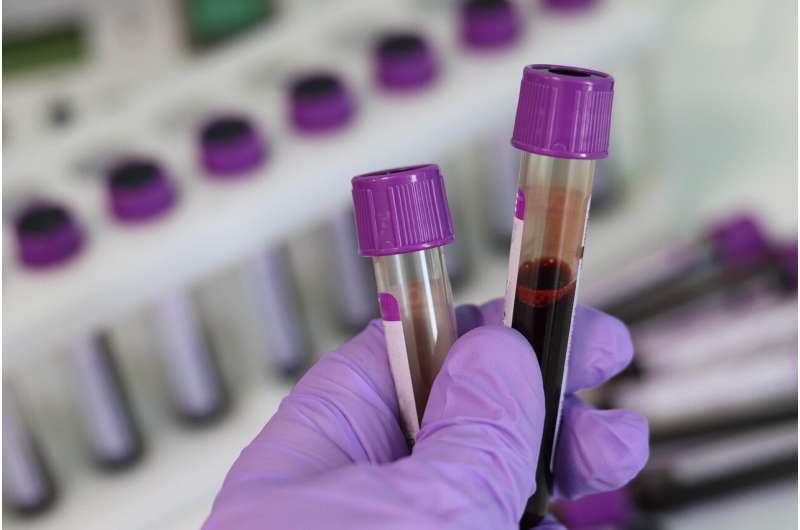Noninvasive prenatal diagnosis for fetal sickle cell disease moves a step closer

Sickle cell disease (SCD) is a form of anemia that is inherited when both parents are carriers of a mutation in the hemoglobin gene. Currently, it can only be diagnosed in pregnancy by carrying out an invasive test that has a small risk of miscarriage and is therefore sometimes declined by parents. Now, researchers from Guy's and St Thomas' NHS Foundation Trust and Viapath Analytics, London, UK, in collaboration with non-invasive healthcare company Nonacus Ltd., Birmingham, UK, have developed a non-invasive prenatal test for the disease, the annual conference of the European Society of Human Genetics will hear tomorrow.
Dr. Julia van Campen, research scientist at Guy's and St Thomas," explains: "We have developed a method of testing for SCD using cell-free fetal DNA—DNA from the fetus that circulates in the maternal bloodstream. Although cell-free fetal DNA testing is already available for some disorders, technical difficulties have hampered the development of such a test for SCD, despite it being one of the most commonly requested prenatal tests in the UK. "
In couples who are at risk of having a baby with SCD, each partner carries a mutation in the hemoglobin gene, which means that any fetus has a one in four chance of inheriting both mutations and therefore being affected by SCD. Non-invasive prenatal diagnosis (NIPD) of conditions that are inherited in this way is difficult. "The development of a non-invasive prenatal assay for sickle cell disease has been attempted before and, until now, has not been successful,"says Dr. van Campen.
The researchers analyzed samples from 24 pregnant SCD carriers. Using unique molecular identifiers, a kind of molecular barcode, they were able to reduce errors, and by only analyzing smaller fragments they were able to enhance the fetal contribution to the samples. This led to successful diagnosis of the sickle cell status for 21 of the 24 pregnancies, in samples from as early as eight weeks gestation, with three samples giving inconclusive results. Further development and validation of the findings is ongoing.
Worldwide, there are over 300,000 children born with SCD each year. It is the most common genetic hematological disorder, with millions of people currently affected across the globe. There are about 14,000 people living with SCD in the UK, or one in 4600. Approximately 560 couples at risk of passing on the disease per year are detected through the national antenatal screening program, which offers carrier testing to pregnant women and if appropriate their partners. Prenatal diagnosis is available to these couples to test whether the fetus has SCD. Previous research has shown that if the option of a non-invasive test were available, more women whose fetus is at risk of sickle cell disease would opt for prenatal testing.
"However, many couples are unaware that they are at risk until pregnancy occurs, even though carrier testing and follow-up genetic counseling is available through the UK National Health Service for those who are concerned that they may carry SCD," says Dr. van Campen. "It is important to raise awareness of SCD, which currently is limited."
Research is ongoing, and before the assay can be introduced into clinical practice it needs to be tested further to be sure that it performs well enough to be used as a diagnostic test. "We also need to work to ensure that it can provide results rapidly enough to give women answers at the right time in their pregnancy, and that it can be performed at a cost that healthcare providers can afford. I am excited that this work has given better results than I had expected, and am hopeful that people will be able to build on this work to make this test available in the near future," Dr. van Campen will conclude.
Chair of the ESHG conference, Professor Joris Veltman, Director of the Institute of Genetic Medicine at Newcastle University, Newcastle upon Tyne, UK, said: "The development of non-invasive genetic tests that can be safely used during pregnancy is important to identify fetuses with severe disorders. These scientists have developed a novel state-of-the art genomics approach to do this for sickle cell disease in couples at risk. Their first results presented at the ESHG conference indicate that their test is very promising."
More information: Frédéric B. Piel et al. Global Burden of Sickle Cell Anaemia in Children under Five, 2010–2050: Modelling Based on Demographics, Excess Mortality, and Interventions, PLoS Medicine (2013). DOI: 10.1371/journal.pmed.1001484



















